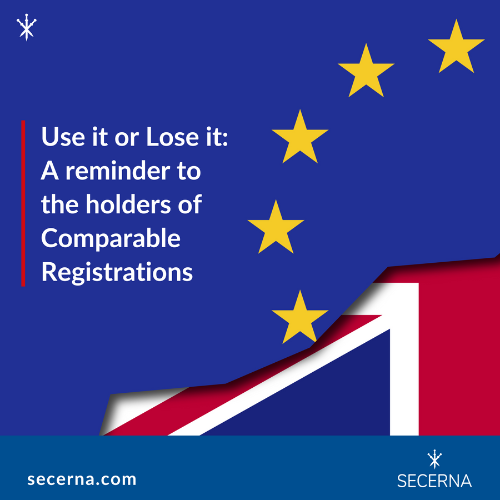Use it or Lose it: A reminder to the holders of Comparable Registrations

As a consequence of Brexit, owners of EU trade mark registrations (EUTM’s, or European Union Trade Marks) were granted an equivalent ‘Comparable’ UK registration. This was to ensure that EU rights holders were not adversely affected as a consequence of Brexit.
Each of these Comparable Registrations:
- Were recorded on the UK Register and afforded the same legal status as if they had been applied for and registered under UK law.
- Kept the original filing date of the corresponding EUTM, with the same goods and services
- Kept the original priority/seniority dates of the corresponding EUTM.
As with any other registered UK trade marks, Comparable Registrations are subject to the same rules regarding ‘use’, i.e., if they have not been put to use for an uninterrupted period of five years they can be revoked on the grounds of non-use and/or can be put to ‘proof of use’ in opposition/invalidation proceedings if they have been registered for more than 5 years. Genuine use means real commercial exploitation of the trade mark in the UK. Failure to use the trade mark can result in the total loss of the UK trade mark.
When enforcing and maintaining these rights, use in in the EU prior to 1 January 2021 could be considered as ‘use’ of the Comparable Registration. Consequently, this has enabled Comparable Registrations to be maintained and enforced even where they have not been used in the UK.
Risks and Actions: Maintaining Comparable Registrations after 2025
However, from 1 January 2026, EU ‘use’ will no longer be considered when assessing the ‘use’ of Comparable Registrations in the UK. Only UK ‘use’ will be relevant in this assessment.
As such, owners of Comparable Registrations may wish to take the following proactive steps in 2025:
- Reviewing their trade mark portfolio to determine the extent to which their trade marks have been put to genuine use in the UK.
- Consider whether their rights as registered reflect their commercial offering in the UK at present.
- If there has been no genuine use in the UK, consider what steps to take to ensure that their trade marks are being put to genuine use in the UK (if, indeed, this still remains a part of their commercial strategy).
- Ensure that thorough records of UK ‘use’ are kept, ready to be used as and when it is necessary to prove use.
Holders of Comparable Registrations should carefully review their portfolios and take action as necessary. By ensuring genuine use in the UK and maintaining meticulous records, rights holders can mitigate the risk of revocation and maintain their competitive edge in the UK market.
Frequently Asked Questions (FAQ)
Q: What changes as of 1 January 2026?
A: From 1 January 2026, only UK use will be considered ‘genuine use’ for the purposes of maintaining and enforcing a Comparable Registration.
Q: How do I prove genuine use of a Comparable Registration?
A: Genuine use means real commercial exploitation of the trade mark in the UK. Essentially, the use of the trade mark must be shown to maintain or create a share in the particular marketplace, and not be ‘token’ use merely to try and maintain trade mark rights. There is no objective ‘minimum’ threshold to prove genuine use, it is a fact dependent, case-by-case analysis relative to the particular characteristics and size of the market in question.
The types of evidence typically required includes sales figures, marketing materials, and other evidence of commercial activity. As such, it is imperative that rights holders keep comprehensive records of all of their trade mark use in the UK.
Q: What happens if I don't use my Comparable Registration in the UK and what are the risks?
A: Another party may apply to revoke your trade mark registration on the grounds of non-use. Only in exceptional circumstances can a Trade Mark Registration be defended and enforced without showing genuine use; namely, when it can be shown that the lack of use is due to variables beyond the brand owners’ control (for example, regulatory barriers or import/export restrictions preventing use of the trade mark).
Furthermore, it is likely to be challenging to enforce the Comparable Registration in any opposition, invalidation or infringement proceedings initiated against another party (where ‘proof of use’ may be requested by the other party).
For more information, visit www.secerna.com





















